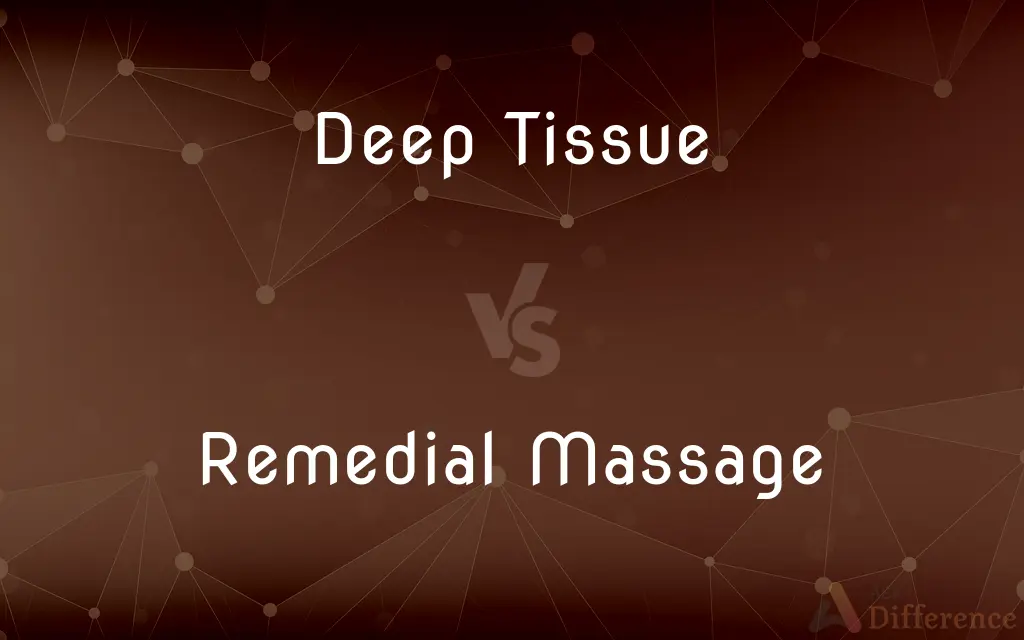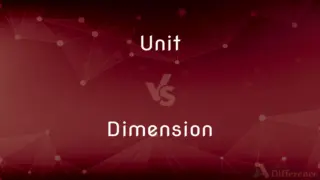Deep Tissue vs. Remedial Massage — What's the Difference?
By Tayyaba Rehman & Fiza Rafique — Published on April 18, 2024
Deep tissue massage realigns deeper muscle layers to ease chronic tension. Remedial massage treats musculoskeletal issues with a diagnostic approach to target pain's root cause.

Difference Between Deep Tissue and Remedial Massage
Table of Contents
ADVERTISEMENT
Key Differences
Deep tissue massage and remedial massage are both therapeutic practices used to alleviate muscle pain and improve physical function, but they differ in their techniques, objectives, and application.
Deep tissue massage employs slow strokes and firm pressure to reach deeper layers of muscle and fascia, primarily aimed at breaking down knots and relieving chronic muscle tension. It is often recommended for individuals who experience consistent pain, are involved in heavy physical activity, or have sustained physical injury.
Remedial massage, on the other hand, is a more targeted therapy designed to treat specific problems within the musculoskeletal system. Practitioners of remedial massage use a diagnostic approach to identify the underlying causes of musculoskeletal issues and tailor their techniques to address these specific problems. This approach may involve a variety of techniques, including muscle manipulation, stretching, and mobilization, to restore the normal function and mobility of the affected area.
Both types of massage can offer significant relief from pain and enhance mobility, but the choice between them depends on the individual’s specific needs. Deep tissue massage is suitable for those looking to relieve deep-seated tension and muscle fatigue, whereas remedial massage is better suited for individuals seeking a customized treatment plan to address particular musculoskeletal complaints.
Comparison Chart
Objective
Relieve chronic muscle tension
Treat specific musculoskeletal issues
ADVERTISEMENT
Technique
Slow strokes, firm pressure
Diagnostic approach, various techniques
Focus
Deeper layers of muscles and fascia
Root cause of pain or dysfunction
Application
General chronic tension and pain
Targeted therapeutic treatment
Benefits
Reduces deep-seated muscle knots
Restores normal function and mobility
Compare with Definitions
Deep Tissue
Often recommended for chronic pain and recovery from injuries.
Post-accident, deep tissue massage was part of his rehabilitation program.
Remedial Massage
Involves assessing and treating specific musculoskeletal dysfunctions.
After evaluating her posture, the remedial massage therapist focused on her tight neck muscles.
Deep Tissue
May cause discomfort during the session but leads to relief.
Although the deep tissue massage was intense, he felt more relaxed and pain-free afterward.
Remedial Massage
Suitable for a wide range of conditions, from acute injuries to chronic pain.
He sought remedial massage treatment for his acute sports injury and experienced significant improvement.
Deep Tissue
Aims to improve blood circulation and reduce inflammation.
Regular deep tissue massage sessions helped reduce her inflammation and improve mobility.
Remedial Massage
Aims to restore the body’s natural movement and function.
Remedial massage therapy helped her recover her range of motion after the injury.
Deep Tissue
Targets the inner layers of muscles and connective tissues.
She found deep tissue massage effective for her chronic back pain.
Remedial Massage
May include home exercises or advice for ongoing care.
Post-session, the therapist gave her exercises to maintain the benefits of the remedial massage.
Deep Tissue
Applies slow, firm strokes to release muscle knots.
The therapist used deep pressure to alleviate the tension in his shoulders.
Remedial Massage
Utilizes a variety of techniques tailored to the individual's needs.
The remedial massage included stretching and mobilization techniques to address his stiff joints.
Common Curiosities
Can deep tissue massage help with injury recovery?
Yes, it can aid in the recovery process by reducing inflammation and improving circulation, though remedial massage might be more appropriate for addressing specific injuries.
Is remedial massage only for people with injuries?
No, while it's beneficial for injury recovery, remedial massage is also suitable for anyone experiencing pain, dysfunction, or mobility issues.
Can I request a combination of deep tissue and remedial techniques in one session?
Yes, many therapists can combine techniques to suit your specific needs and goals for the session.
Will I experience pain during these massages?
While some discomfort is common, especially with deep tissue massage, communicate with your therapist to ensure the pressure is within your tolerance level.
How often should I get a deep tissue or remedial massage?
The frequency depends on your condition and goals. Your therapist can recommend a treatment plan, but sessions can range from weekly to monthly.
Can deep tissue or remedial massage cause bruising?
While not common, slight bruising can occur due to the pressure applied. If you're concerned, discuss this with your therapist before starting the session.
How do I know if I need deep tissue or remedial massage?
Choose deep tissue massage for general chronic tension or pain. Opt for remedial massage if you have specific musculoskeletal issues requiring a tailored approach.
Are there any conditions for which these massages are not recommended?
Certain conditions, like acute injuries, inflammation, or specific medical conditions, may require you to consult a healthcare provider before receiving massage therapy.
What qualifications should a therapist have for providing these massages?
Look for therapists with certifications in deep tissue or remedial massage from accredited institutions and who have a good understanding of human anatomy and physiology.
Is there any follow-up care after a deep tissue or remedial massage?
Therapists may recommend hydration, stretching exercises, or rest as part of the follow-up care to enhance the benefits and aid in recovery.
Share Your Discovery

Previous Comparison
Vodka vs. Gin
Next Comparison
Unit vs. DimensionAuthor Spotlight
Written by
Tayyaba RehmanTayyaba Rehman is a distinguished writer, currently serving as a primary contributor to askdifference.com. As a researcher in semantics and etymology, Tayyaba's passion for the complexity of languages and their distinctions has found a perfect home on the platform. Tayyaba delves into the intricacies of language, distinguishing between commonly confused words and phrases, thereby providing clarity for readers worldwide.
Co-written by
Fiza RafiqueFiza Rafique is a skilled content writer at AskDifference.com, where she meticulously refines and enhances written pieces. Drawing from her vast editorial expertise, Fiza ensures clarity, accuracy, and precision in every article. Passionate about language, she continually seeks to elevate the quality of content for readers worldwide.













































